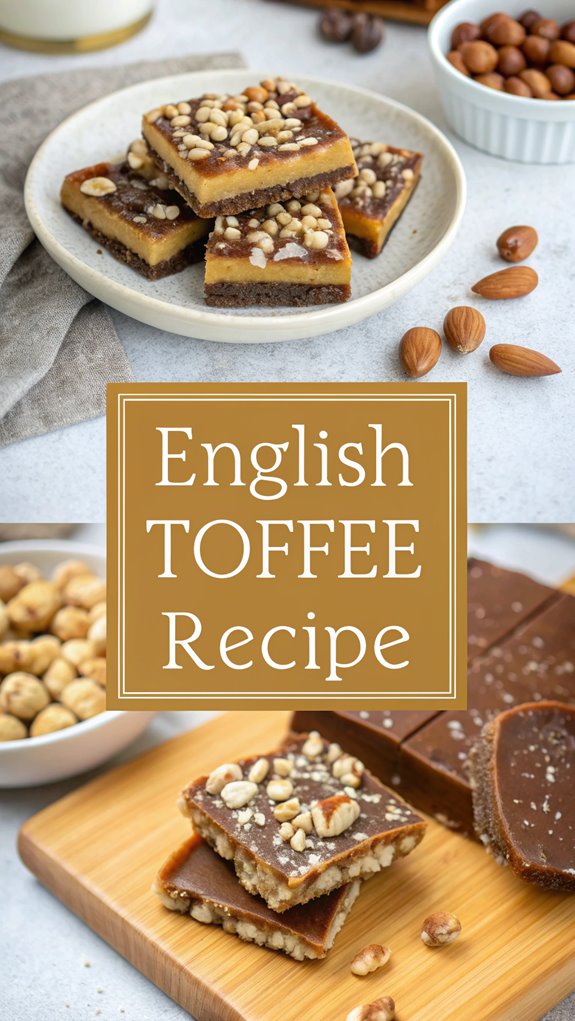English Toffee Recipe
If you’re looking to craft a classic English toffee, you’ll appreciate how simple ingredients come together to create something truly indulgent. This treat not only requires attention to detail but also offers a rich history that enhances its charm. As you explore the nuances of technique and flavor, you might find yourself wondering how variations can elevate the experience even further. Stick around, and you might discover just what it takes to perfect your own version of this timeless confection.
Why You’ll Love This Recipe
When you plunge into making this English toffee recipe, you’ll discover a delightful balance of flavors and textures that’s hard to resist. The key ingredients—rich butter, granulated sugar, and a hint of vanilla—work together to create a creamy, smooth base. As the sugar caramelizes, it transforms into a golden brown color, giving the toffee its signature look.
You’ll love the crunchy texture that comes from adding nuts like almonds or pecans. These not only provide a satisfying crunch but also enhance the overall flavor. Topping the toffee with a thin layer of dark chocolate adds a rich, sweet contrast that melts in your mouth, making each bite a delightful experience.
Using a sturdy saucepan is essential for even heat distribution, while a wooden spoon helps prevent sugar crystals from forming. Keeping a close eye on the temperature—between 290-300°F—is vital for achieving that perfect brittle texture. Reaching a hard crack temperature ensures the toffee has the desired consistency that makes it so enjoyable.
With options to customize by choosing different nuts or chocolate types, you can make this recipe truly your own. Ultimately, this English toffee offers a satisfying blend of crunchy, creamy, and sweet elements that you’ll want to share with friends and family.
History
The rich flavors and textures of English toffee have a fascinating history that dates back to 18th century England. Initially, this delightful treat was a simple hard candy made from sugar and butter, boiled until it reached a brittle state.
As the 1800s progressed, English toffee evolved, with the addition of almonds creating a crunchy texture that many people loved. By the early 1900s, recipes began including these nuts, and the name “English toffee” emerged, inspired by the distinct sound it makes when bitten into.
This beloved candy spread throughout England and eventually around the world as people immigrated and traveled. By the 1920s, major candy makers started selling English toffee globally, keeping the basic ingredients of butter, sugar, and almonds largely unchanged.
Today, English toffee remains a cherished treat, especially during the holiday season, due to its nostalgic appeal. While there are variations, like the American buttercrunch, traditional English toffee focuses on pure flavors with minimal chocolate, celebrating its rich history. This confection represents many manufacturers still handcraft these recipes, ensuring that the classic taste continues to delight people around the world.
Recipe

English Toffee Recipe
English toffee is a classic confection that’s perfect for any occasion, whether you’re celebrating a holiday or simply indulging your sweet tooth. The delightful combination of buttery toffee, rich chocolate, and crunchy nuts creates a treat that’s hard to resist. Making your own toffee at home not only allows you to customize the flavors and ingredients, but it also fills your kitchen with an irresistible aroma that will have everyone excited to taste. Additionally, the simple process of making toffee means you won’t need a candy thermometer, making it accessible for any home cook.
The process of creating this delectable treat may seem intimidating at first, but with the right technique and a little patience, you’ll find it to be a rewarding experience. Follow these simple steps to whip up a batch of homemade English toffee, perfect for sharing or keeping all to yourself!
Ingredients:
– 1 cup unsalted butter
– 1 cup granulated sugar
– 1/4 teaspoon salt
– 1 teaspoon vanilla extract
– 1 cup chocolate chips (milk, dark, or semisweet)
– 1 cup chopped nuts (almonds, peanuts, or walnuts)
Cooking Instructions:
- Begin by preparing your workspace. Line a baking sheet with parchment paper or a silpat, and set it aside for later use. This will provide a non-stick surface for pouring the toffee.
- In a heavy pot, combine the unsalted butter, granulated sugar, and salt. Heat the mixture over medium heat until it begins to boil, stirring constantly to prevent any burning or sticking.
- Once the mixture reaches a boil, insert a candy thermometer. Continue to cook the toffee, stirring constantly, until it reaches a temperature of 300 degrees Fahrenheit or becomes the color of a brown paper bag.
- Carefully pour the hot toffee onto the prepared baking sheet, spreading it into an even layer with a spatula if necessary. Allow the toffee to cool slightly for a minute.
- Immediately sprinkle the chocolate chips over the warm toffee. Let them sit for a minute to melt, then use a spatula to spread and smooth the melted chocolate evenly over the surface.
- While the chocolate is still soft, sprinkle the chopped nuts on top, pressing them gently into the chocolate. Allow the toffee to cool at room temperature for about an hour, or until the chocolate has hardened.
- Once set, break the toffee into pieces and store in a tightly sealed container at room temperature for up to a month.
Extra Tips:
When making English toffee, it’s essential to avoid using margarine, as it contains too much water and can lead to separation.
Be gentle while stirring to guarantee the toffee remains smooth and avoid adding water, which can disrupt the cooking process.
Cleaning your pot can be made easier by filling it with hot water to dissolve any residual toffee.
Finally, remember not to double the recipe; cooking in smaller batches yields better results. Enjoy your homemade English toffee!
Final Thoughts
Ultimately, making English toffee at home can be a delightful and rewarding experience. By using high-quality ingredients like unsalted butter, granulated sugar, and quality chocolate, you set the foundation for a delicious treat.
Remember, the type of sugar you use is essential; granulated sugar is necessary for the right texture, while brown sugar won’t work. Cooking techniques play a significant role as well. Stir constantly to guarantee even melting, and keep a close eye on the temperature. You want to reach the hard crack stage between 290-300°F for that perfect crispness. Additionally, using heavy-bottomed saucepans can significantly improve your cooking results due to their even heat distribution.
A heavy-bottomed saucepan helps with even heat distribution, so don’t skip this step. Once your toffee is ready, cool it just enough to add your chocolate chips. Spread the melted chocolate evenly and top it with toasted nuts for added flavor.
Chilling the toffee helps set the chocolate, making it easier to break into pieces. Finally, be patient throughout the process. Avoid doubling the recipe and guarantee all your equipment is clean.
With these tips, you’ll create a delicious batch of English toffee that’s sure to impress!
FAQ
Making English toffee at home raises a lot of questions, especially for first-timers. One common question is about the ingredients. You’ll need granulated sugar, high-quality butter, nuts like almonds or pecans, and chocolate chips, either milk or semi-sweet. A bit of water can also help prevent the toffee from separating.
When it comes to cooking techniques, remember that reaching the right temperature is crucial. Heat the mixture to 300°F (150°C) and stir constantly to guarantee even melting. Using a heavy-bottomed saucepan will help manage the foaming mixture. The cooking process involves melting butter with sugar and monitoring the temperature closely to ensure it reaches the hard crack stage.
Once you pour it out, spread the toffee quickly into a rough rectangular shape.
You might wonder about variations. Feel free to experiment with different nuts or chocolate types. Some people even add vanilla or salt for extra flavor, but it’s optional.
If you encounter issues, like separation or burning, adding a small amount of water can help, and be careful not to overheat beyond 300°F.
Finally, using quality ingredients matters—poor-quality chocolate or butter can ruin your toffee. Following these tips will lead you to delicious homemade English toffee!

English Toffee Recipe
Ingredients
- Ingredients:
- - 1 cup unsalted butter
- - 1 cup granulated sugar
- - 1/4 teaspoon salt
- - 1 teaspoon vanilla extract
- - 1 cup chocolate chips milk, dark, or semisweet
- - 1 cup chopped nuts almonds, peanuts, or walnuts
Instructions
- Cooking Instructions:
- Begin by preparing your workspace. Line a baking sheet with parchment paper or a silpat, and set it aside for later use. This will provide a non-stick surface for pouring the toffee.
- In a heavy pot, combine the unsalted butter, granulated sugar, and salt. Heat the mixture over medium heat until it begins to boil, stirring constantly to prevent any burning or sticking.
- Once the mixture reaches a boil, insert a candy thermometer. Continue to cook the toffee, stirring constantly, until it reaches a temperature of 300 degrees Fahrenheit or becomes the color of a brown paper bag.
- Carefully pour the hot toffee onto the prepared baking sheet, spreading it into an even layer with a spatula if necessary. Allow the toffee to cool slightly for a minute.
- Immediately sprinkle the chocolate chips over the warm toffee. Let them sit for a minute to melt, then use a spatula to spread and smooth the melted chocolate evenly over the surface.
- While the chocolate is still soft, sprinkle the chopped nuts on top, pressing them gently into the chocolate. Allow the toffee to cool at room temperature for about an hour, or until the chocolate has hardened.
- Once set, break the toffee into pieces and store in a tightly sealed container at room temperature for up to a month.
- Extra Tips:
- When making English toffee, it's essential to avoid using margarine, as it contains too much water and can lead to separation.
- Be gentle while stirring to guarantee the toffee remains smooth and avoid adding water, which can disrupt the cooking process.
- Cleaning your pot can be made easier by filling it with hot water to dissolve any residual toffee.
- Finally, remember not to double the recipe; cooking in smaller batches yields better results. Enjoy your homemade English toffee!
